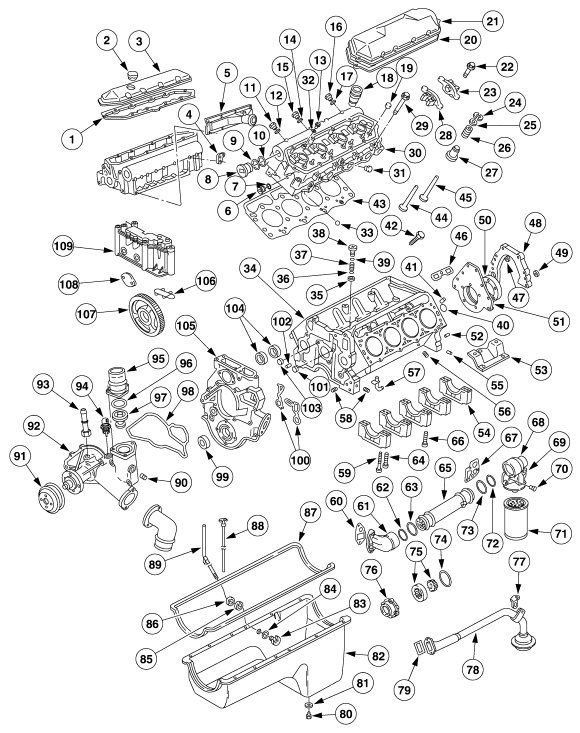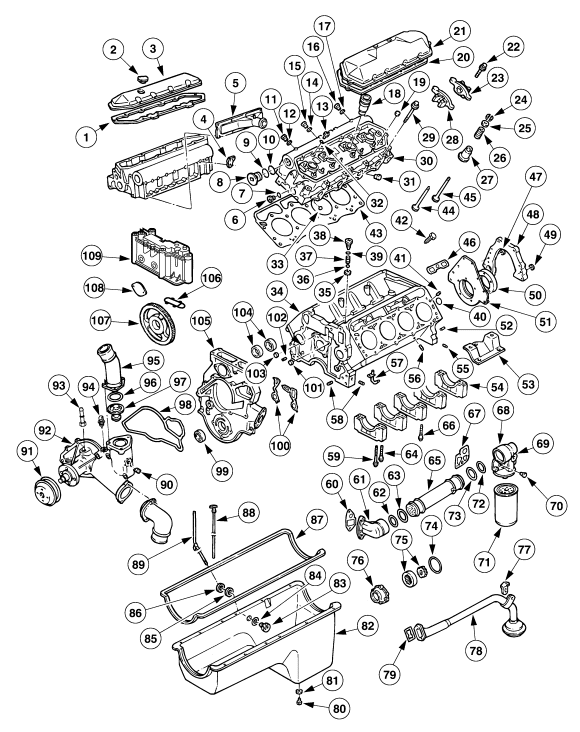A 4 cycle Turbocharged V8 with Overhead Valves and a 444 cubic inch displacement designed and built to withstand the riggers of diesel operations for a long time. Over engineered when compared to the previous IDI model, the 7.3L PSD cast iron cylinder block uses 4 bolt main bearing caps, internal piston cooling jets, a forged steel crankshaft, and heavy duty steel connecting rods. The free floating type pistons are made of cast aluminum alloy and are fitted with a keystone upper compression ring, rectangular lower compression ring, and oil control rings. The gear driven camshaft is supported by 5 insert type bearings of the roller camshaft design. Hydraulic valve tappets minimize engine noise, maintain zero lash, and incorporate camshaft follower guides to reduce camshaft wear. The cast iron cylinder heads have high pressure oil galleries and incorporate the HUEI fuel injectors with the injectors placement in the center of the combustion chambers between the rocker arms. They also utilize six bolts per cylinder for maximum strength. The power train control module (PCM) controlled glow plug system preheats the cylinders with glow plugs installed in the heads for faster cold weather starts. The cast iron block and heads provide increased durability but the tradeoff is slower and inefficient heat transfer so there is also a block heater for heating the engine coolant and oil for improved cold weather starts. There is a 2 part lubrication system divided into the low pressure (10-60psi) system for lubricating the engine itself and the high pressure system (600-3000psi) for actuating the injectors. Despite its popularity, production of the 7.3L PSD ended in 2003 due to increased emissions and noise regulations.
The engine serial number for your 7.3L Power Stroke is located on the rear oil cooler where the oil filter assembly mounts to the engine block. 99+ models also have an engine serial number label on the drivers side valve cover.
7.3L Power Stroke Diesel Engine Factory Specifications
|
||||||||
| Years Produced | 1994.5 – 2003 | |||||||
| Displacement | 7.3 Liters (444 Cubic Inches) | |||||||
| Block Material | Cast Iron | |||||||
| Head Material | Cast Iron | |||||||
| Connecting Rods Material* | Forged Steel (‘94.5 – ’00)
Powdered Metal (’01 – ’03) |
|||||||
| Compression Ration | 17.5:1 | |||||||
| Firing Order | 1-2-7-3-4-5-6-8
7 8 5 6 3 4 1 2 front of engine |
|||||||
| Bore | 4.11 in (104.4mm) | |||||||
| Stroke | 4.18 in (106.2mm) | |||||||
| Turbo | 94-97: Garrett TP38
99-2003: Garrett GTP38 (Waste Gate) 99+ had turbo intercooler |
|||||||
| Injection | Direct Injection, HEUI | |||||||
| Valve train | Over Head Valve, 2 valves per cylinder
hydraulic lifters |
|||||||
| Engine Weight | 920lbs dry | |||||||
| Oil Capacity | 15 Quarts including Oil Filter | |||||||
| Peak Horsepower | 210 hp @ 3000 rpm (‘94.5) 275 hp @ 2800 rpm (’03) |
|||||||
| Peak Torque | 425 lb-ft @ 2000 rpm (‘94.5) 525 lb-ft @ 1600 rpm (’03) |
|||||||
| B10 Life | 200,000 miles | |||||||
| B50 Life | 350,000 miles | |||||||
Here is a copy of a Powertrain Engine Ford Workshop Manual (Open or Save) for the 1999 F-Super Duty 250-550 that contains a plethora of information for the 7.3L Power Stroke Engine the first part is for up to December 1998 and then the next nearly identical section is for December 1998 and newer.
Here is a breakout of the 1999+ 7.3L Power Stroke:
Here is a breakout of the up to 1998 7.3L Power Stroke:
*Navistar began installing a test run of powdered metal rods (PMR) beginning in 2001. They installed 14,965 sets of these powdered metal rods were installed along side of forged steel rods until Navistar committed to switch fully to powdered metal rods for the duration of the 7.3L’s production life.
Start of production– Engine S/N: 1425746 = Forged
Engine S/N: 1425747 – 1440712 = PMR
Engine S/N: 1440713–1498318 = Forged
Engine S/N: 1498319–final production = PMR
Why this matters: Forged rods are capable of withstanding up to 600 rear wheel hp and tend to bend rather than break, while the powdered metal rods are rated at 500 rear wheel hp or below and the powdered metal tends to snap or break rather than bend.

